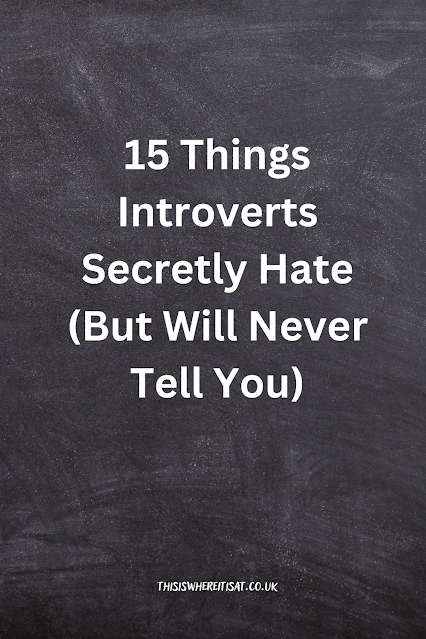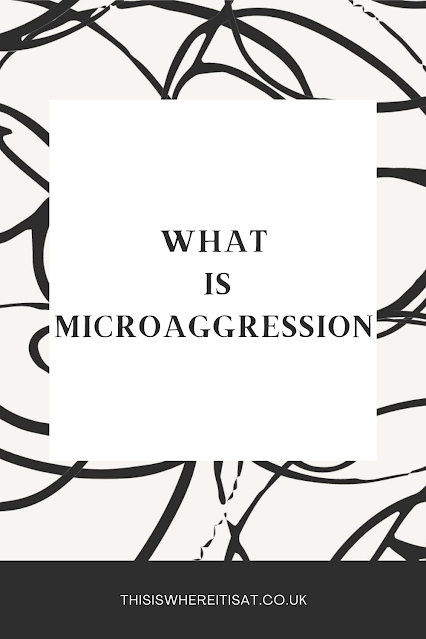Understanding the condition IIH (Idiopathic Intracranial Hypertension)
15 Things Introverts Secretly Hate (But Will Never Tell You)
Introverts are often misunderstood, their quiet demeanour mistaken for aloofness or disinterest.
1. Small Talk Overload.
Introverts value meaningful conversations over trivial small talk.
Constantly bombarded with superficial chatter can drain their energy and leave them exhausted.
2. Forced Socialising.
Being pushed into social situations without prior warning can be incredibly uncomfortable for introverts.
They prefer to have time to prepare themselves mentally for social interactions.
3. Crowded Events.
Large crowds and noisy environments can be overwhelming for introverts.
They thrive in quieter, more intimate settings where they can engage in deeper conversations.
4. Unsolicited Advice.
Introverts are often independent thinkers who prefer to figure things out independently.
Unsolicited advice can come across as intrusive and patronising, causing them to feel annoyed and misunderstood.
5. Interrupted Alone Time.
Introverts cherish their alone time as an opportunity to recharge and reflect.
Interrupting during these moments can disrupt their inner peace and make them irritable.
6. Group Projects.
While collaboration can be valuable, introverts may dread group projects that require constant interaction and compromise.
They prefer working independently or in smaller, more manageable groups.
7. Unexpected Phone Calls.
Introverts prefer written communication over phone calls, giving them time to gather and respond thoughtfully.
Unexpected phone calls can catch them off guard and leave them feeling anxious.
8. Being Put on the Spot.
Introverts tend to be more reserved and thoughtful in their responses.
Being put on the Spot in social or professional settings can make them feel uncomfortable and pressured to perform.
9. Overly Assertive Individuals.
Introverts value harmony and may feel uncomfortable around overly assertive or domineering individuals.
They prefer interactions characterised by mutual respect and consideration.
10. Constantly Being Told to "Come Out of Their Shell".
Introverts often face pressure to be more outgoing and friendly.
While they may appreciate encouragement to step out of their comfort zone, constantly being told to "come out of their shell" can dismiss their natural tendencies.
11. Being Misunderstood as Shy or Anti-Social.
Introverts are not necessarily shy or anti-social; they prefer more profound, meaningful connections over superficial interactions.
Being misunderstood as shy or anti-social can frustrate introverts, as it overlooks their unique strengths and perspectives.
12. Frequent Interruptions During Work or Study Time.
Introverts thrive in environments that allow them to focus intensely on their work or studies.
Frequent interruptions can disrupt their concentration and hinder their productivity.
13. Unexpected Changes to Plans.
Introverts tend to prefer structure and predictability.
Unexpected changes to plans can throw off their rhythm and leave them unsettled.
14. Being Expected to "Just Get Over It".
Introverts may need time to process their thoughts and emotions before they feel ready to move on from a challenging situation.
Being expected to "just get over it" can feel dismissive of their need for introspection and reflection.
15. Feeling Overwhelmed by Social Obligations.
Introverts value quality over quantity when it comes to social interactions.
Feeling overwhelmed by a never-ending stream of social obligations can leave them drained and emotionally depleted.
In conclusion, while introverts may not always vocalise their dislikes, certain situations can make them feel unstable or misunderstood.
By being mindful of these potential triggers, we can create more inclusive environments that support introverts' unique needs and preferences.
Cheers for reading X
What is microaggression
In recent years, the concept of microaggressions has gained significant attention in discussions surrounding discrimination and social justice.
While these acts may seem insignificant individually, their cumulative effect can profoundly impact the mental and emotional well-being of those targeted.
In this blog post, we will explore microaggressions, their different forms, and their broader implications for society.
Defining Microaggressions.
Microaggressions manifest in various forms and can target race, gender, sexual orientation, religion, disability, and other identities.
They can occur in interpersonal interactions, institutional settings, and even through the media.
What distinguishes microaggressions from overt acts of discrimination is their subtle and often unconscious nature, making them challenging to recognise and address.
Types of Microaggressions.
Microaggressions can be categorised into three main types: micro assaults, microinsults, and microinvalidations.
1. Micro assaults.
These are explicit acts intended to harm or offend someone based on their identity.
They can include racial slurs, homophobic remarks, or sexist jokes.
While more blatant, micro assaults still operate on a smaller scale compared to overt acts of violence or discrimination.
2. Microinsults.
Microinsults are subtle comments or actions that convey rudeness, insensitivity, or demeaning attitudes toward a person's identity.
An example might be asking people of colour where they are "really" from, implying they are not truly English.
These remarks undermine the individual's sense of belonging and perpetuate stereotypes.
3. Micro validations.
Micro validations dismiss or negate marginalised individuals' experiences, feelings, or identities.
This can include statements like "I don't see colour" or "You're too sensitive."
By invalidating a person's reality, microinvalidations deny the impact of systemic oppression and undermine efforts toward equality.
The Impact of Microaggressions.
While seemingly minor, microaggressions have significant repercussions for those who experience them.
They create a hostile and unwelcoming environment, eroding trust and psychological well-being.
Over time, the cumulative effect of microaggressions can lead to increased stress, anxiety, depression, and feelings of alienation.
Moreover, microaggressions reinforce existing power dynamics and perpetuate systemic inequality.
By perpetuating stereotypes and marginalising certain groups, they contribute to a culture of discrimination and exclusion.
This affects individuals on a personal level and has broader societal implications, hindering progress towards a more equitable and inclusive society.
Addressing Microaggressions.
Recognising and addressing microaggressions is crucial for creating a more inclusive and respectful environment.
This requires both individual and institutional efforts.
1. Raise Awareness.
Educating people about microaggressions and their harmful effects is the first step toward addressing them.
Encouraging open dialogue and providing training on unconscious bias can increase Awareness and sensitivity to these issues.
2. Challenge Biases.
Individuals must be willing to examine their own biases and assumptions.
This means actively challenging stereotypes and prejudices and being mindful of the language and actions used towards others.
3. Create Inclusive Spaces.
Institutions and organisations have a responsibility to create environments that are inclusive and welcoming to all.
This may involve implementing diversity and inclusion policies, providing cultural competency training, and fostering a culture of respect and acceptance.
4. Listen and Validate.
When someone experiences a microaggression, listening to their concerns and validating their experiences is essential.
Belittling or dismissing their feelings only perpetuates the harm caused by microaggressions.
5. Hold Accountable.
Individuals who perpetrate microaggressions must be held accountable for their actions.
This may involve addressing the behaviour directly, providing education and resources for change, and implementing consequences for repeat offenders.
Microaggressions may be subtle, but their impact is far-reaching.
By undermining the dignity and worth of marginalised individuals, they perpetuate inequality and contribute to a culture of discrimination.
Recognising and addressing microaggressions is essential for creating a more inclusive and equitable society where all individuals can thrive.
Through education, Awareness, and concerted action, we can work toward a future free from the harmful effects of microaggressions.
Cheers for reading x
How Living with Less Can Save You Money and Reduce Stress
In today's consumer-driven world, we're constantly bombarded with messages to acquire more.
Minimalism is a philosophy that focuses on intentionality and what truly matters.
It offers a surprising solution to our biggest struggles: financial strain and overwhelming stress.
Financial Freedom through Reduced Spending.
Curbing Impulse Purchases: By uncluttering your life, you become keenly aware of what you already own.
This newfound awareness eliminates the urge to buy things you don't need, leading to significant savings.
Prioritising Needs over Wants.
Minimalism compels you to differentiate between needs and wants.
You'll prioritize essential items like food, shelter, and healthcare while minimizing spending on fleeting desires.
Investing in Quality over Quantity.
Minimalism encourages buying well-made, long-lasting items.
This shift from fast fashion and low-quality goods to durable products saves money in the long run.
Reduced Storage Costs.
Owning less translates to needing less space.
This can lead to downsizing your living situation, significantly lowering your housing or storage costs.
Stress Reduction through a Simpler Life.
Uncluttering Mental Space: Physical clutter often creates mental clutter.
Uncluttering your surroundings frees up mental space, reducing feeling overwhelmed.
Easier Decision-Making.
With fewer possessions, you have less to manage and maintain.
This simplifies daily routines and eliminates the stress of decision fatigue, which is the mental strain caused by having too many choices.
Focus on Experiences.
Minimalism encourages prioritizing experiences over material possessions.
Investing in travel, hobbies, or spending quality time with loved ones fosters a sense of fulfilment and lasting memories.
Increased Time and Energy.
Less stuff means less cleaning, organizing, and maintaining.
This frees up valuable time and energy you can devote to activities that bring you joy and reduce stress.
Getting Started with Minimalism.
Embracing minimalism doesn't require drastic life changes.
Here are some practical steps to get you started.
Unclutter Regularly.
Start small. Dedicate a specific time each week or month to unclutter a particular area of your home.
Donate, sell, or recycle items you no longer need or use.
Resist Impulse Purchases.
Ask yourself, "Will I use this regularly?" and "Does this bring me joy?".
Implement a waiting period before buying non-essential items to curb impulse spending.
Embrace Multipurpose Items.
Opt for furniture and appliances that serve multiple functions. These reduce clutter and save space.
Focus on Experiences.
Budget for experiences that create lasting memories, like attending a concert or taking a weekend trip, instead of focusing solely on material possessions.
Minimalism is a journey, not a destination.
By gradually incorporating its principles into your life, you'll not only save money but also experience a significant stress reduction.
Remember, true wealth lies not in the abundance of things you own but in the richness of your life.
Cheers for reading x
Everything you need to know about sensory processing disorder!
Hey readers,
Sensory Processing Disorder (SPD) occurs when the brain has difficulty receiving and responding to information from the senses.
For individuals with SPD, the world can feel overwhelming and confusing, leading to challenges in daily life. In this blog post, we'll explore the signs and symptoms of SPD and strategies to support individuals with this condition.
What is Sensory Processing Disorder?
Sensory Processing Disorder, also known as Sensory Integration Dysfunction, is when the brain has trouble organising and making sense of the information it receives from the senses.
This can include the five main senses: sight, hearing, touch, taste, and smell, as well as the sense of movement and body position (proprioception) and balance (vestibular sense).
Individuals with SPD may experience sensory input differently than others. For example, they may be overly sensitive to certain sensations, such as loud noises or scratchy clothing, or seek sensory input, such as rocking or spinning, to feel more regulated.
Signs and Symptoms of Sensory Processing Disorder.
While every individual with SPD is unique and may experience symptoms differently, there are some common signs to look out for:
1. Overly sensitive to sensory input.
Individuals with SPD may be hypersensitive to certain sensations, such as loud noises, bright lights, strong smells, or certain textures.
They may react strongly or negatively to these stimuli, becoming overwhelmed or anxious.
2. Under-reactive to sensory input.
On the other hand, some individuals with SPD may be hypersensitive, meaning they have a diminished response to sensory input.
They may seek intense sensory experiences like spinning or jumping to feel more alert or engaged.
3. Difficulty with transitions.
People with SPD may struggle with transitions between activities or environments.
They may become upset or anxious when routines are disrupted or when faced with new or unfamiliar situations.
4. Poor motor coordination.
SPD can affect motor skills and coordination, making tasks such as writing, tying shoelaces, or catching a ball challenging. Individuals may appear clumsy or uncoordinated in their movements.
5. Avoidance of certain activities.
Due to sensitivity to certain sensory inputs, individuals with SPD may avoid certain activities or environments.
For example, they may refuse to participate in activities that involve loud noises or crowded spaces.
6. Sensory seeking behaviours.
Some individuals with SPD may seek out sensory input to feel more regulated. This can include rocking, spinning, or chewing on objects.
7. Difficulty with self-regulation.
SPD can impact an individual's ability to regulate their emotions and behaviour.
They may have difficulty calming down when upset or become easily overwhelmed by sensory stimuli.
8. Social and emotional challenges.
Sensory processing difficulties can impact social interactions and emotional regulation.
Individuals with SPD may have difficulty understanding social cues, making friends, or expressing their emotions effectively.
Strategies for Supporting Individuals with SPD.
While SPD can present challenges, some strategies and interventions can help individuals manage their symptoms and thrive:
1. Create a sensory-friendly environment.
Make adjustments to the individual's environment to minimise sensory triggers.
This can include using soft lighting, providing noise-cancelling headphones, or offering fidget toys to help regulate sensory input.
2. Establish predictable routines.
Consistent routines can help individuals with SPD feel more secure and comfortable.
Provide visual schedules or timers to help them anticipate transitions and prepare for activity changes.
3. Provide sensory breaks.
Offer regular breaks throughout the day to allow the individual to regulate their sensory input.
This can include short walks, movement breaks, or quiet time in a calm, sensory-friendly space.
4. Offer sensory-friendly activities.
Incorporate activities that provide sensory input in a controlled and regulated manner.
This can include swinging, bouncing on a therapy ball, or engaging in tactile play with sensory materials.
5. Use sensory tools and equipment.
Utilise sensory tools and equipment to help individuals regulate their sensory input.
This can include weighted blankets, compression garments, or sensory integration therapy equipment.
6. Practice relaxation techniques.
Teach individuals relaxation techniques such as deep breathing exercises or progressive muscle relaxation to help them calm their nervous system and manage sensory overload.
7. Provide support and understanding.
Offer support and understanding to individuals with SPD, acknowledging their unique sensory needs and challenges.
Encourage open communication and allow them to express their feelings and preferences.
8. Seek professional support.
Consult with occupational therapists or other healthcare professionals who specialise in sensory processing disorders.
They can provide individualised assessments and interventions to help manage symptoms and improve quality of life.
Sensory Processing Disorder is a complex condition that can present challenges in daily life, but with understanding and support, individuals with SPD can learn to manage their symptoms and thrive.
By recognising the signs and symptoms of SPD and implementing strategies to support sensory processing needs, we can create a more inclusive and accommodating environment for individuals of all sensory profiles.
Together, we can work towards a world where everyone's sensory needs are understood and respected.
Cheers for reading X
When is it time to cut ties with harmful family?
Having toxic or abusive family members can take an immense toll on your mental health.
Look for Patterns of Harm.
The first step is identifying if this is part of a larger pattern of harm, or isolated incidents. Does this family member have an ongoing negative influence through actions like:
* Physical, verbal or emotional abuse.
*Manipulation, gaslighting or lying.
- Substance abuse issues.
* Refusing treatment for mental health issues.
* Repeated boundary violations and disrespect.
* Bullying behaviour or enabling harm by others.
If you notice a persistent pattern of toxicity, it likely won't change without consequences. In that case, limiting contact may be healthiest.
Consider Your Needs.
Your wellbeing should come first. Reflect on how interacting with this relative truly makes you feel day to day.
* Hurt, belittled, or mistreated.
* Depression or confusion.
* Like you're "walking on eggshells".
If the relationship is eroding your self-worth and emotional health, distance may be best for now. Prioritise loving yourself.
Set Clear Boundaries.
Before cutting off contact completely, you may want to first establish clear boundaries.
For instance, you might say: "If you continue to insult me, I will immediately leave the conversation." Then follow through consistently. This communicates what you need clearly.
Have a Game Plan.
Cutting ties will likely cause fallout, so have a plan. To limit drama:
* Do it privately - don't announce it publicly.
* Share the news in a brief, composed manner, not in an emotional outburst.
* Offer to revaluate down the road if changes occur.
* Then disengage from negativity - don't get pulled into arguments.
Also brace yourself for potential retaliation like guilt trips, insults, or manipulation. Stay grounded in your worth.
Seek Support.
Leaning on supportive loved ones as you distance yourself can make a huge difference. Turn to trustworthy friends who validate your feelings and needs.
If you have other relatives who understand, ask them to not take sides. Therapy can also help give you tools and perspective. Don't isolate yourself if things get hard.
Practice Self-Care.
Cutting off family - even toxic family - can feel devastating. Make sure you implement plenty of self-care to cope, including:
* Treating yourself kindly during this transition.
* Spending time with chosen family who uplift you.
* Engaging in hobbies and activities that bring you joy.
* Getting counselling or joining a support group.
* Practicing relaxation techniques like meditation.
* Fostering your physical and mental health.
By nurturing yourself, you can heal and build confidence in this new chapter.
While painful, distancing from abusive or unstable family may ultimately empower you to live more fully.














